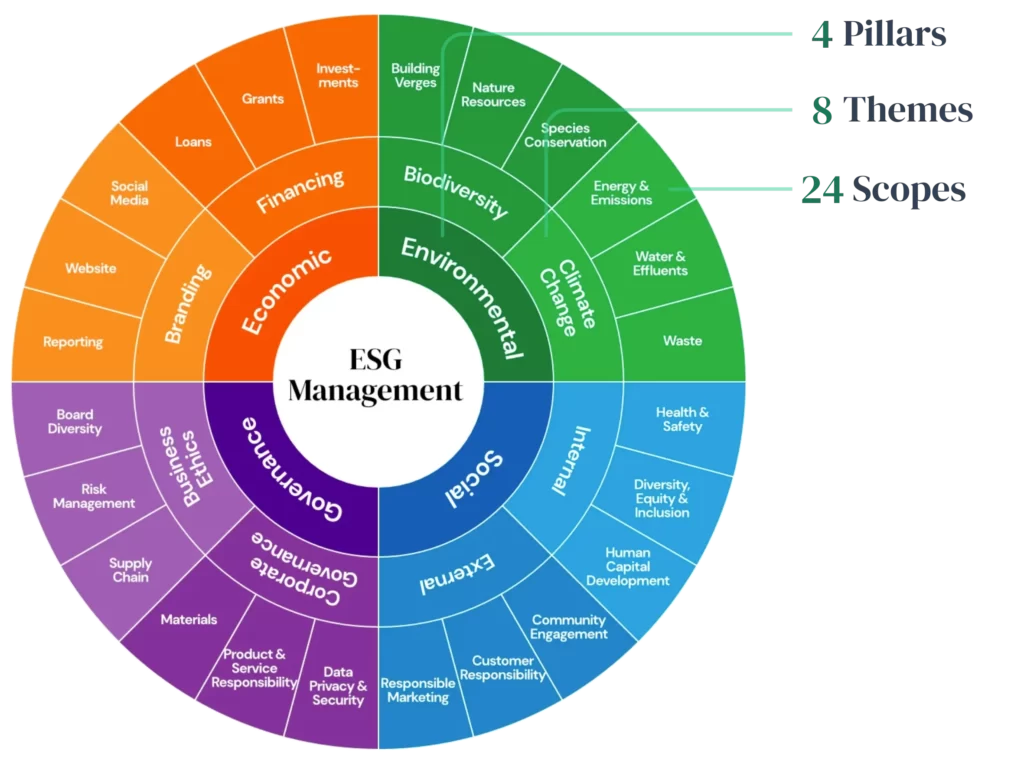ESG Reporting
The 6 Benefits of Making an ESG Report

Visualize adherence to sustainability goals

Identify opportunities for improvement in business and its expansion

Foster better engagement with consumers, employees, financial institutions and investors

Provide transparency and efficiency in supply chain

Enhance competitiveness in the export market

Encourage accountability and reputation in global market
The 6 Steps to Make an ESG Report
Step 1
Gather information from the company’s leadership on what they consider exists within their sphere of influence and identify the company’s value chain.
Step 2
identify and categorize risks and opportunities that could affect the performance of the company along its value chain.
Step 3
Write a report outlining these risks and opportunities to communicate them to stakeholders.
Step 4
Decide how frequently reports will be made.
Step 5
Make the follow-up process manageable for employees by figuring out what information needs to be collected and by whom.
Step6
Make an action plan for how these risks and opportunities will be dealt with at the company.
ESG Acceleration

ESG Management
A sustainable economy is essential for successful ESG outcomes, and successful ESG practices can lead to a more sustainable economy.
What gets measured, gets managed!
ESG Training
We are committed to equipping individuals and organisations with the knowledge, skills, and tools needed to navigate the complexities of sustainability and responsible business practices.
A Holistic ESG Mastery Program

Fundamental
- ESG Opportunities and Risks
- ESG Regulations and Frameworks
- ESG Assessment and Reporting
Enhancement
- Deep Dive into Environmental Matters
- Deep Dive into Social Matters
- Deep Dive into Governance Matters
Management
- Data Collection and Analytics
- Business Strategy and Operations
- Investment and Finance
What Information Must Be Included in an ESG Report?
ESG reports should include information on environmental performance such as energy use, greenhouse gas emissions, water usage , waste generated, material used, and waste management.
They should also include information on social aspects such as labor practices, human rights impacts, community engagement, diversity efforts from suppliers, and any other issues related to the company’s interactions with society.
Lastly, reports should include information on governance such as compliance, board structure including diversity of race or gender of the board members , political contributions, policies related to the environment and society, and any other issues regarding how the company interacts with government.


ESG Reporting as a Tool for Companies
ESG reporting is an opportunity for companies to communicate sustainability goals to stakeholders in order to understand their business from a holistic perspective. By communicating these goals, it helps foster relationships with investors and stakeholders. The idea is that as a company works, (a work in progress), towards its goals, it can be held accountable to these goals and improve over time. The end goal is to contribute to the company’s long-term success.
ESG reporting is also a tool for companies who want to attract talent from outside their industry. It is a way for companies to showcase their efforts in environmental and social responsibility, which is becoming increasingly important when recruiting new employees.
Finally, ESG reporting is a way for companies to communicate how their efforts and goals fit into a larger scope of social and environmental issues facing society. The end goal being to be sustainable.
The information in an ESG report should be easy to understand (Holistic Approach) and available in a format that is relevant and useful for each audience.
ESG reporting is an important tool for companies to communicate their commitment to sustainability goals and provide transparency to stakeholders about their environmental, social, and governance risks and opportunities.
By including relevant data, management commentary, and future plans, ESG reporting can help companies identify areas for improvement, foster stakeholder engagement and accountability, provide transparency, and impact consumers, employees, and investors.
To make an effective ESG report, companies should gather information from leadership, identify risks and opportunities, write a report, decide on frequency, make follow-up manageable, and create an action plan.
The report should cover both current and future performance and include information on environmental, social, and governance aspects. ESG reporting is not only a tool for companies to improve their sustainability efforts but also attract talent and communicate their contributions to social and environmental issues facing society.
